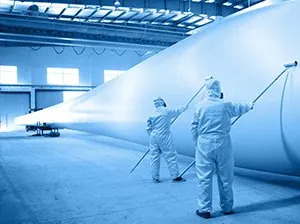All industrial facilities are different, however, there is one common thread in each facility – metal. Metal is a material that is widely used in industrial environments due to its increased versatility and durability.
However, condensation is another commonality in these environments as large machinery often produces high amounts of heat, and condensation can be bad for the paint that protects the metal.
The more heat generated in an enclosed space, the higher the humidity level in that area. When the temperature of the metal floors, walls, equipment and other surfaces in the space is lower than the humidity in the air, condensation will settle along these surfaces, and for painted metal surfaces this is especially problematic.
You can use this guide to learn how to protect your painted metal surfaces.
Condensation Threats
In terms of painted metal, it’s safe to label condensation as somewhat of a kryptonite to the paint. Unless the surface is coated with a specialized paint or seal, the moisture buildup will cause the paint to chip and peel. While this is unattractive, the problems don’t stop there.
Industrial paint often contains additives that seal and protect metal; however, as the paint chips or peels away, it leaves the metal exposed and vulnerable. Over time, this creates the ideal environment for corrosion to form. One of the most problematic things about corrosion is that it easily spreads.
The result of this expansion is a larger area of damage and more significant repair needs. Therefore, keeping the paint in place by minimizing condensation is essential.
Minimize Condensation
Keeping the paint in place on metal surfaces is at the foundation of the fight against corrosion, and the best way to go about this process is to fight condensation. Here are just a few of the things you can do to work toward this goal in your facility.
Improve Ventilation
Humidity becomes a significant factor in enclosed spaces with poor airflow. While your large equipment will still generate a fair amount of heat, the more air that circulates through the facility, the more this moisture-ridden air will cycle out of the area, and the more rapidly any condensation settled on the surfaces in the space will evaporate.
If you have not had your ventilation system inspected in several years, now might be a good time to do so.
Increase Insulation
As previously stated, condensation occurs when the surface temperature of an object is significantly lower than the humidity the air. Insulation helps shrink this gap by increasing the temperature of the surfaces in the building and also helps minimize the level of heat loss in the building.
In simple terms, instead of escaping, the heat will be used to warm up the surfaces in the facility so that there is less of a temperature difference between the surfaces and the air. Ideal insulation involves the block of heat transfer through the wall cavities, floor slabs and ductwork.
Apply Additives
Paint additives are another approach you can use to fight condensation, and they work somewhat similar to insulation. Silica aerogel is an additive sometimes added to industrial paint solutions. This additive is thought to be useful because it raises the insulating value of whatever material it is applied over.
In terms of metal surfaces, this insulation boost will also help minimize the difference between the temperature of the surface and the air’s humidity.
Our team at N.J. McCutchen, Inc. is here to meet all your industrial paint needs. From painting new equipment to touch-ups to paint preservation, our team will use their years of experience to help you find the best long-term solutions. Contact us today.
